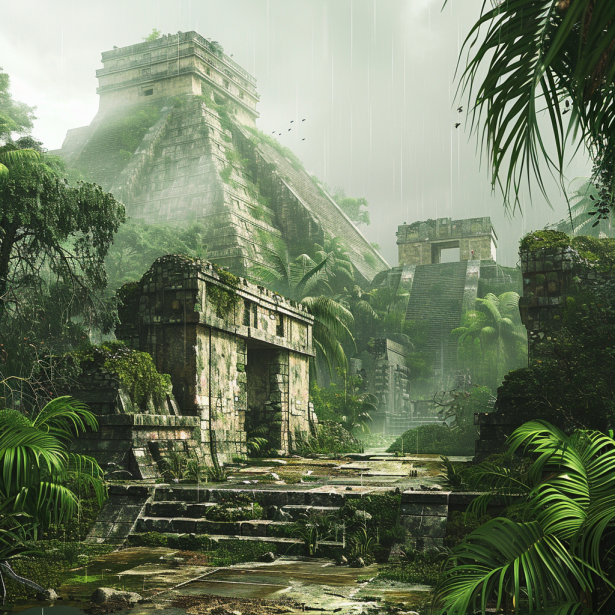Introduction
Around the 9th century CE, the thriving Classic Maya civilization in Mesoamerica suddenly declined, leaving behind deserted cities like Tikal and Copán. Theories for this collapse include intense warfare, social unrest, severe droughts, and climate change. Environmental stress from deforestation and internal conflicts may have played key roles in their downfall, sparking ongoing debate and research.
The Classic Maya Civilization
Peak of the Maya
- Flourishing Cities: The Classic period of the Maya civilization (250-900 CE) saw the rise of major city-states such as Tikal, Copán, Palenque, and Calakmul. These cities were known for their impressive architecture, complex social structures, and advancements in mathematics, astronomy, and writing.
- Cultural Achievements: The Maya developed a sophisticated writing system, known as hieroglyphics, and made significant astronomical and calendrical calculations. Their monumental architecture, including pyramids, temples, and palaces, reflected their religious and political power.
The Sudden Decline
Deserted Cities
- Abandoned Centers: By the end of the 9th century, many major Maya cities were abandoned. Populations dwindled, monumental construction ceased, and the intricate political systems collapsed.
- Remaining Populations: While the core areas of the civilization experienced a decline, some regions, especially in the northern Yucatán Peninsula, saw the continuation of Maya culture into the Postclassic period.
Theories Behind the Collapse
Environmental Stress
- Deforestation and Soil Depletion: Intensive agricultural practices led to deforestation and soil exhaustion. The loss of forests reduced the capacity to retain water, leading to erosion and declining agricultural productivity.
- Severe Droughts: Paleoclimatic evidence suggests that the Maya region experienced prolonged droughts during the Terminal Classic period. These droughts would have severely impacted water supply and agriculture, leading to food shortages and social stress.
Climate Change
- Climatic Shifts: Studies indicate that shifts in climate, including changes in rainfall patterns, could have disrupted the delicate balance of the Maya agricultural system. Reduced rainfall and prolonged dry seasons would have exacerbated the existing environmental stresses.
Social and Political Unrest
- Intense Warfare: Increased warfare among city-states is evident from archaeological records. Fortifications, mass graves, and iconographic evidence suggest that conflicts became more frequent and intense, destabilizing the region.
- Political Fragmentation: The complex political system of the Maya, characterized by competing city-states, may have led to political fragmentation. As alliances shifted and rivalries intensified, the cohesion of the civilization weakened.
Internal Conflicts
- Social Unrest: Evidence of social unrest, such as revolts and the overthrow of elites, points to internal conflicts. Disparities in wealth and power, combined with environmental and resource pressures, may have fueled dissatisfaction and rebellion.
- Economic Strain: The economic burden of maintaining large populations and constructing monumental buildings could have strained resources. As the ability to sustain these activities diminished, so did the support for ruling elites.
Archaeological Evidence and Research
Multi-Disciplinary Studies
- Paleoenvironmental Analysis: Studies of lake sediments, stalagmites, and other natural records provide insights into the climatic conditions during the Classic period. These analyses have revealed periods of significant drought and environmental change.
- Archaeological Excavations: Excavations of Maya sites have uncovered evidence of warfare, such as fortifications and mass burials, as well as signs of abrupt abandonment. Artifacts and inscriptions offer clues about the social and political dynamics of the time.
Modern Interpretations
- Complex Interplay: Modern scholars agree that the collapse of the Maya civilization was likely due to a complex interplay of environmental, social, and political factors. No single cause can fully explain the widespread decline.
- Continuing Debate: The debate continues as new evidence emerges and analytical techniques improve. Researchers are piecing together a more comprehensive understanding of the factors that contributed to the Maya collapse.
Legacy and Impact
Maya Culture Today
- Survival of Maya Communities: Despite the collapse of the Classic Maya civilization, the descendants of the Maya continue to live in the region, maintaining many aspects of their cultural heritage. Languages, traditions, and practices have endured and evolved over centuries.
- Cultural Resilience: The Maya civilization’s achievements in architecture, writing, and science remain a testament to their ingenuity and resilience. Their legacy continues to influence modern understanding of ancient civilizations.
Lessons for Modern Society
- Environmental Sustainability: The Maya collapse serves as a cautionary tale about the consequences of environmental degradation and unsustainable agricultural practices. It highlights the importance of managing natural resources wisely.
- Political and Social Stability: The decline also underscores the fragility of complex societies in the face of internal and external pressures. Lessons from the Maya collapse can inform contemporary discussions on governance, resource management, and social cohesion.
Conclusion
The mysterious decline of the Classic Maya civilization remains one of the most intriguing puzzles in ancient history. Theories ranging from environmental stress and climate change to social unrest and warfare offer insights into the multifaceted nature of their collapse. Ongoing research continues to shed light on this enigmatic period, providing valuable lessons for understanding the complexities of human societies and their interactions with the environment.
FAQs
What was the Classic Maya civilization?
The Classic Maya civilization, which thrived between 250 and 900 CE, was known for its impressive cities, advanced writing system, astronomical knowledge, and monumental architecture.
When did the Maya civilization begin to decline?
The decline began around the 9th century CE, leading to the abandonment of major city-states such as Tikal and Copán.
What are some theories behind the Maya collapse?
Theories include environmental stress from deforestation and soil depletion, severe droughts, climate change, intense warfare, social unrest, and political fragmentation.
How do researchers study the Maya collapse?
Researchers use paleoenvironmental analysis, archaeological excavations, and modern analytical techniques to study the environmental, social, and political factors that contributed to the Maya collapse.
What lessons can we learn from the Maya collapse?
The Maya collapse highlights the importance of environmental sustainability, effective resource management, and social and political stability. It serves as a cautionary tale for managing the complexities of modern societies.

